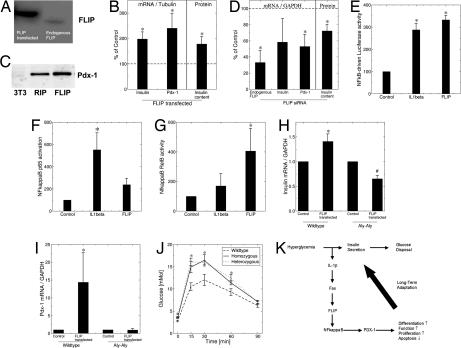Fig. 4.
FLIP regulates insulin and PDX-1 mRNA expression via the alternative pathway of NF-κB activation. INS-1E (A and E–G), wild-type, and aly/aly (B–D, H, and I) mouse islet cells were transfected with a mock vector or a vector encoding for FLIP (FLIP transfected) or exposed to siRNA to FLIP. (A) Immunoblotting of FLIP. (B and D) RT-PCR detection of insulin, PDX-1, and FLIP mRNA expression and islet insulin content. The level of mRNA expression was normalized to tubulin or GAPDH, and the results are expressed as mRNA levels relative to controls. (C) Immunoblotting of PDX-1 in islets and in 3T3 cells (negative control) transfected with the RIP vector alone and with RIP-FLIP. One of two experiments is shown. (E–G) Analysis of NF-κB activity by detection of luciferase activity after transfection of an NF-κB-driven firefly luciferase construct normalized to a cotransfected constitutive Renilla luciferase construct (E) and by detection of p50–p65 (F) and RelB (G) binding to an NF-κB consensus site. The effect of FLIP was compared with 150 pg/ml IL-1β (n = 4, each in duplicate). (H and I) RT-PCR of insulin (H) and PDX-1 (I) mRNA normalized to GAPDH (n = 3–4). ∗, P < 0.05 relative to wild-type control; #, P < 0.05 relative to aly/aly control. (J) Blood glucose levels after i.p. injection of glucose (2 mg/g of body weight) in male homozygous and heterozygous aly/aly mice and C57BL/6 (wild-type) mice. ∗, P < 0.05 homozygous, heterozygous vs. wild type (n = 6, 5, and 5, respectively, for each group). (K) Hypothetical model illustrating the consequence of limited hyperglycemia on β cell production of IL-1β in parallel with insulin secretion. The paracrine effect of IL-1β induces Fas engagement, which, in the presence of FLIP, leads to β cell proliferation, differentiation, and increased function.

